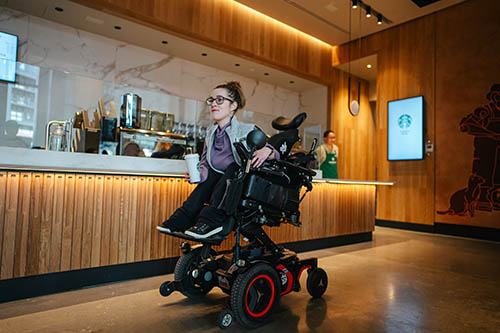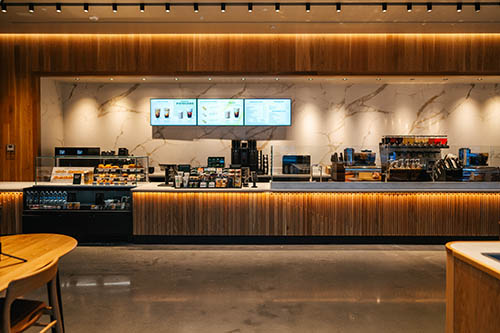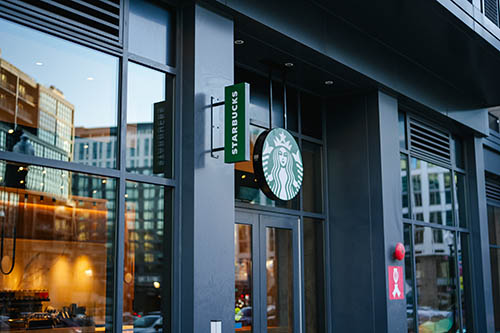Seattle — On Feb. 16, 2024, Starbucks Coffee Company announced that it is creating a more accessible store experience across its U.S. store portfolio through an Inclusive Spaces Framework. The first store to be built using the inclusive design framework opened on Feb. 16 in Washington, D.C. The new store features items such as optimized acoustics and lighting for improved visual and audible communication for customers and accessible equipment designs for a better partner (employee) experience among other features.

The Inclusive Spaces Framework was created in partnership with a diverse community of customers, partners and accessibility experts to develop scalable solutions for retail spaces. Moving forward, all newly built and renovated Starbucks company-operated stores in the U.S. will begin to incorporate the framework, a key milestone in ensuring Starbucks continues to expand accessibility and inclusion. The framework will also be open sourced and further developed to help expand accessibility across the retail industry.
“At Starbucks, we have challenged ourselves to imagine what’s possible when we take a closer look at the many ways our partners and customers interact with us and experience our stores every day,” says Katie Young, senior vice president of store operations. “Building and scaling an Inclusive Store Framework is central to our mission of connection and will lead to greater access for all.”
An estimated 1 in 4 adults in the United States has a disability and Starbucks is working to better meet these needs. The Inclusive Spaces Framework is already intentionally embedded into the company’s rapid store growth plans in the U.S.

According to Laxman Narasimhan, CEO of Starbucks, the company plans to continue to open more stores, growing by approximately 4% this year in the U.S. on a base of over 16,000, including licensed stores. Further, new company-operated stores in the U.S. are averaging unit volumes of approximately $2 million with ROIs of approximately 50%.
Some of the physical and digital features that Starbucks will begin to incorporate include:
• Updated Point-of-Sale (POS): The updated point-of-sale (POS) system is customized to meet the needs of more partners and customers. It’s now portable for improved ease of use with customers, has an adjustable angle stand for better visibility, an intuitive and customizable layout, offers voice assist and screen magnification, shows images of menu items to support language diversity and provides visual order confirmation to help ensure order accuracy.
• Customer Order Status Boards: Customer order status boards will offer customers visual update on where their order is in the process, and when it’s ready to be picked up — providing multiple ways of communicating.
• Power-Operated Doors: Wherever possible, doors to store entrances will include a longer vertical push button that is easier to activate from more heights and angles, designed to reduce the effort required to open the door.
• Optimized Acoustics and Lighting: Acoustics and lighting features help create a more inclusive auditory and visual experience for customers and partners. Stores will use materials to reduce unwanted background noise and reverberation that can interfere with assistive devices like hearing aids, and lighting that minimizes glare, shadow patterns and backlighting that can impede visual communication.
• Inclusive Equipment Design: Starbucks Clover Vertica™ brewer was built to include a more accessible store experience for our partners including design features such as a larger dial and button that protrude for a more accessible reach and visual and haptic confirmation, including a light to notify when brewing is complete.
• Paths of Travel: Store designs will create a continuous, unobstructed pedestrian path, allowing people to approach, enter, explore, enjoy and exit the store with ease where possible. This includes open sightlines, barrier free pathways with more accessible wayfinding to accommodate varying heights, distances and iconography.
• Connection: To nurture a culture of connection between customers and partners, counters are lower with overhangs to accommodate wheelchair access and support better communication when picking up food and beverages.
“Starbucks opening of their new store built with inclusive design elements is a big moment as we try to make retail spaces more accessible and inclusive,” says Tony Coelho, a former U.S. congressman, primary author and sponsor of the Americans with Disabilities Act (ADA). “We have to go beyond just what is required to put accessibility and inclusion first to ensure all people feel like they belong in community spaces.”
Founded 1971, Starbucks Coffee Company has more than 38,000 stores worldwide. For more information, visit www.starbucks.com.
SOURCE: Starbucks Coffee Company

